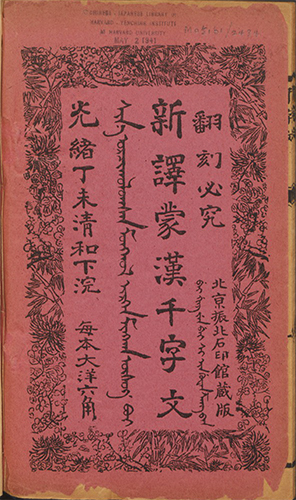19 Mongolian

The Thousand Character Classic (Chinese: 千字文), also known as the Thousand Character Text, is one of the earliest and most widespread basic literacy texts for the study of classical Chinese. The rhyming text was composed by learned and talented scholar Zhou Xingsi of the Southern Liang dynasty (502-557) and has been used ever since as a primer for teaching Chinese characters to children. It contains exactly one thousand non-redundant characters arranged into 250 four-character couplets. Not only is the form succinct and poetic, but the text also imparts traditional Chinese knowledge and wisdom. It was widely circulated in ancient Japan, Korea, and Vietnam. It has also been translated into several western languages, including English, Latin, German, Italian, and French. The New Mongolian Translation of the Thousand Character Classic contains traditional Uyghur-Mongolian and Chinese text, as well as Manchu phonetic transcription. It is valuable for the study of Mongolian and Manchu phonology. The C.V. Starr East Asian Library owns a facsimile of the 1907 stone print edition. The original edition is held by the Harvard-Yenching Library and was recently digitized.
The course description for Mongolian 1A follows: “Mongolian is the language of a people who politically have emerged on the world stage after verily hundreds of years of imposed isolation, who geographically live on the vast open steppe that ranges from the Gobi to Siberia, who economically juggle an ancient tradition of pastoral nomadism with the development of national and private industry, who culturally know an eclectic, vibrant cosmopolitanism belied by their rugged open spaces, and who long ago established the largest contiguous empire the world has ever known.”1 UC Berkeley has a long tradition of Mongolian Studies reaching back to the early 20th century. In 1935, Ferdinand Lessing, a German scholar of Central Asia, was named the fourth Agassiz Professor of East Asian Studies and established this country’s first course in the Mongolian language, as well as courses on Mongolia’s Buddhist tradition. He also published the first scholarly Mongolian-English dictionary in 1960.2 Mongolian studies continued to advance under the direction of Professor James Bosson, who taught at Berkeley from 1964 through 1996. He was also a renowned scholar for the Manchu and Tibetan languages. Students at Berkeley begin with Khalkha Mongolian, the standard language of Mongolia, in its context as a dialect of Mongolian language proper using Cyrillic script and introducing traditional script. They then advance to Literary Mongolian, its phonetics, grammar, vertical writing system and its relation to living spoken language.
With a generous gift from the government of Mongolia, UC Berkeley and the Institute of East Asian Studies launched the Mongolia Initiative in 2016. Mongolian is now being taught on campus for the first time in many years by Professor Brian Baumann who concentrates on Mongolian texts on Buddhism, history and culture. Funding from the U.S. Department of Education has also supported the language program and other research activities on Mongolian as well as for enrichment of the Mongolian collection in the Library.
Contribution by Jianye He
Librarian for the Chinese Collections, C.V. Starr East Asian Library
Sources consulted
Title in English: The New Mongolian Translation of the Thousand Character Classic
Author: Zhou, Xingsi, d. 521.
Imprint: Beijing : Zhen bei shi yin guan, Guangxu ding wei, 1907.
Edition: n/a
Language: Mongolian
Language Family: Mongolic
Source: Harvard College Library Harvard-Yenching Library
URL: http://nrs.harvard.edu/urn-3:FHCL:10443432
Select Print editions at Berkeley:
- Facsimile reprint has been published in volume one of 清代蒙古文啓蒙讀物薈萃 = Qing dai Menggu wen qi meng du wu hui cui. Huhehaote Shi : Yuan fang chu ban she, 2016.

